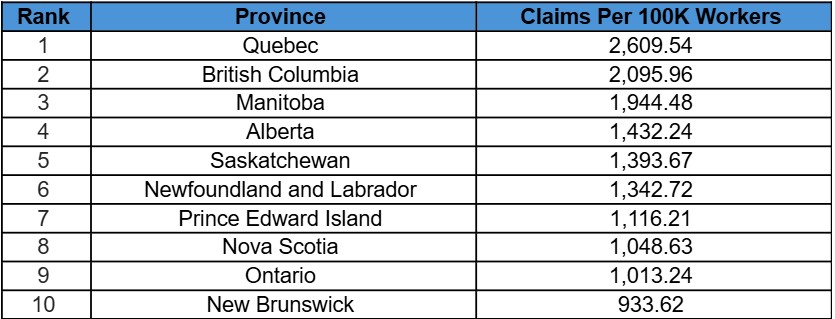
Report looks at lost-time claims per 100,000 workers in 2023

Danger is lurking around workers, and Quebec stands out as the most dangerous province to work, according to a recent report.
Overall, Quebec has 2,609.54 lost-time claims per 100,000 workers in 2023, according to a report from Preszler Injury Lawyers.
British Columbia comes in at second at just over 2,600 lost-time claims per 100,000 workers and Manitoba sits at third with just under 2,000 per 100,000 workers.

Source: Preszler Injury Lawyers
Recently, a 19-year-old female worker at Walmart in Nova Scotia died in the workplace.
Meanwhile, ranking 10th is New Brunswick, with 933.62 lost-time claims per 100,000 workers, making this the least dangerous province to work in. New Brunswick experienced 3,896 lost-time claims in 2022, which is 2% higher than the total of 3,837 in 2021.
Ontario and Nova Scotia ranked 9th and 8th, respectively.

Source: Preszler Injury Lawyers
However, Ontario recorded the highest increase in numbers compared to the other provinces. The province had 1,013.24 lost-time claims per 100,000 employees in 2023. In 2022, Ontario experienced 85,859 lost-time claims, an 18% increase from the previous year’s total of 72,921.
In reporting the numbers, Preszler Injury Lawyers examined the latest data from the Association of Workers’ Compensation Boards of Canada and Statistics Canada on the number of accepted lost-time claims and the size of the labour force in each province.
With these numbers, Preszler Injury Lawyers is reminding employers to keep workers safe in the workplace.
“A lost-time claim is the compensation that is paid to an employee who is absent from the workplace for more than eight working days. A workplace injury affects the entire team, causing delays in the completion of tasks, lower morale, and less productivity,” said a spokesperson from the firm in an email.
“However, the impacts on the individual can also be extremely damaging. These may include anxiety due to unsafe conditions, high medical costs, and increased stress. It is crucial that employers maintain a hygienic and safe workplace environment to prevent employees from becoming injured or falling ill.”
Canadian health and safety legislation requires employers to have a health and safety program in their workplace, according to the Canadian Centre for Occupational Health and Safety (CCOHS).
“A written occupational health and safety policy helps define and promote an effective [occupational health and safety] program. Such a policy should communicate the employer’s commitment to a healthy and safe workforce, be signed by senior management, be reviewed regularly, and updated as needed.
“This document will assist in writing and applying an OHS policy for the workplace.”
Conflict resolution has emerged as one of the most sought-after training topics for frontline managers amid growing concerns about customer incivility, according to a previous report from Axonify.
Also, hundreds of Canadian correctional officers in different parts of the country rallied in front of the regional headquarters of Correctional Services Canada (CSC) previously to ask for better contacts from their employer amid rising safety concerns.